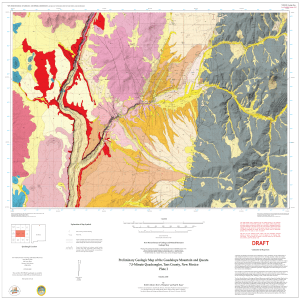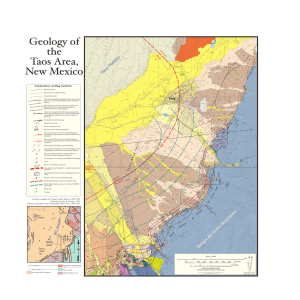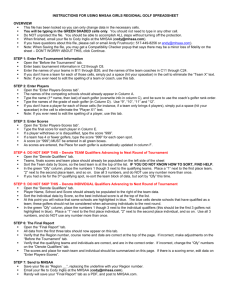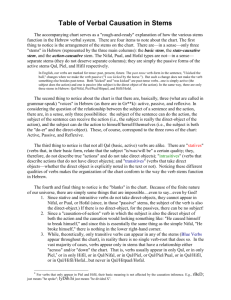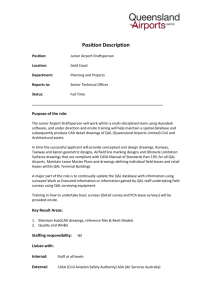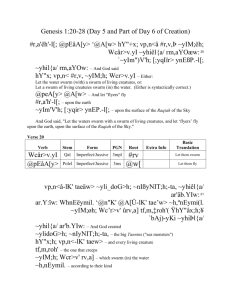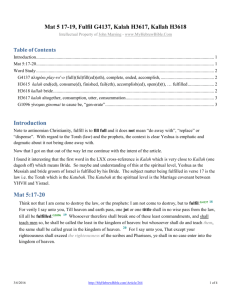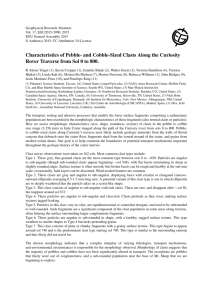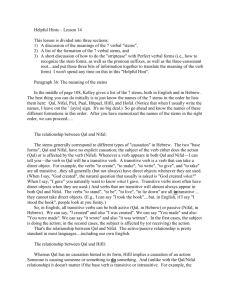Document 10895712
advertisement
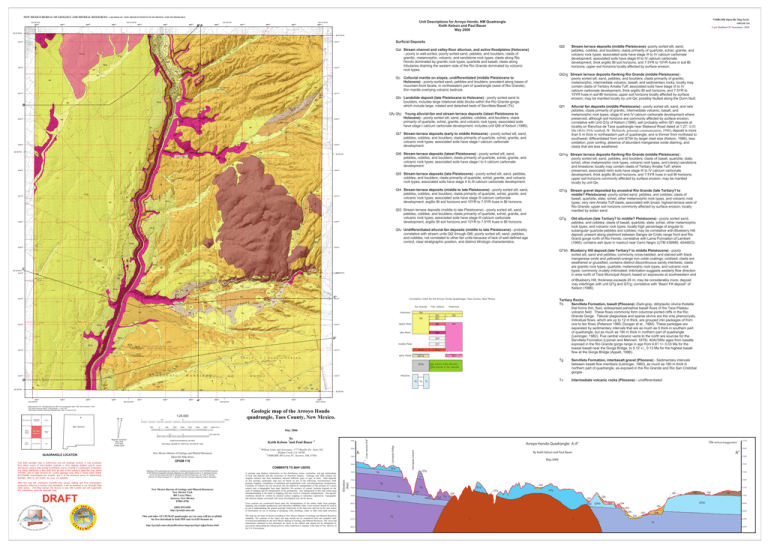
NEW MEXICO BUREAU OF GEOLOGY AND MINERAL RESOURCES 105°45'0"W 433000 434000 36°37'30"N A DIVISION OF NEW MEXICO INSTITUTE OF MINING AND TECHNOLOGY 435000 105°42'30"W 436000 437000 438000 B' A 439000 105°40'0"W 440000 441000 442000 443000 444000 Qls Qal Tucem Qal Qfy Qfy Tv 36°37'30"N Qfy 4053000 Surficial Deposits 4053 000 Qls QTg Tb Tb Tucem QTrg Tb Qfy Tg Tg Qal Stream channel and valley-floor alluvium, and active floodplains (Holocene) - poorly to well-sorted, poorly sorted sand, pebbles, and boulders; clasts of granitic, metamorphic, volcanic, and sandstone rock types; clasts along Rio Hondo dominated by granitic rock types, quartzite and basalt; clasts along tributaries draining the western side of the Rio Grande dominated by volcanic rock types. Qal Qfy Qls QTrg 4052000 4052 000 Qfy Qls Qal QTg(sc) Tg Qfy Qfv Tb Qfu Tg Qls 4051000 Qal Qal Qt7a Qt6 Qfu Qfy 4051 000 Qls Landslide deposit (late Pleistocene to Holocene) - poorly sorted sand to boulders, includes large rotational slide blocks within the Rio Grande gorge, which include large, rotated and detached beds of Servilleta Basalt (Tb) Qt7 Qt1rg Qfu Qfy Qfy 4050000 Qfy Qty: Young alluvial-fan and stream terrace deposits (latest Pleistocene to Holocene) - poorly sorted silt, sand, pebbles, cobbles, and boulders; clasts primarily of quartzite, schist, granite, and volcanic rock types; associated soils have stage I calcium carbonate development; includes unit Qt8 of Kelson (1986). QTg Qls Qal 4050 000 Tv Tv QTg Qt7 Qfu Qfy Qfy Qal QTg Qal Qt2 Qt7 Stream terrace deposits (early to middle Holocene) - poorly sorted silt, sand, pebbles, cobbles, and boulders; clasts primarily of quartzite, schist, granite, and volcanic rock types; associated soils have stage I calcium carbonate development. Qfy Tb Qfy Qfy 4049000 4049 000 QTg Qt2 Tv 36°35'0"N Tg Qfy Qfv Qto Qt6 Stream terrace deposits (latest Pleistocene) - poorly sorted silt, sand, pebbles, cobbles, and boulders; clasts primarily of quartzite, schist, granite, and volcanic rock types; associated soils have stage I to II calcium carbonate development. 36°35'0"N Tv Qfy Tg QTg 4048000 4048 000 Tg Tg Qt4 Stream terrace deposits (middle to late Pleistocene) - poorly sorted silt, sand, pebbles, cobbles, and boulders; clasts primarily of quartzite, schist, granite, and volcanic rock types; associated soils have stage III calcium carbonate development, argillic Bt soil horizons and 10YR to 7.5YR hues in Bt horizons. Qfy Qfy QTrg 4047000 QTg Tb Qfy Qt1rg Qt2rg Qfy Qal Td Qt7 Qt2 4047 000 Qt1rg Td Qt2rg 4046000 4046 000 Qal Qt1rg Qfy Qfy Qal Td Qal 4045000 QTg Qfu Undifferentiated alluvial fan deposits (middle to late Pleistocene) - probably correlative with stream units Qt2 through Qt6; poorly sorted silt, sand, pebbles, and cobbles; not correlated to other fan units because of lack of well-defined age control, clear stratigraphic position, and distinct lithologic characteristics. QTg Qt1rg QTrg Stream gravel deposited by ancestral Rio Grande (late Tertiary? to middle? Pleistocene) -poorly sorted sand, pebbles, and cobbles; clasts of basalt, quartzite, slate, schist, other metamorphic rock types, and volcanic rock types; very rare Amalia Tuff clasts; associated with broad, highest terrace west of Rio Grande; upper soil horizons commonly affected by surface erosion; locally mantled by eolian sand. Qt3 Stream terrace deposits (middle to late Pleistocene) - poorly sorted silt, sand, pebbles, cobbles, and boulders; clasts primarily of quartzite, schist, granite, and volcanic rock types; associated soils have stage III calcium carbonate development, argillic Bt soil horizons and 10YR to 7.5YR hues in Bt horizons. QTg Qty 4045 000 Qfy Qal 36°32'30"N C 4044000 QTg Tb Qt1rg Tb Qfy Qal Qfy Qfy Qt3 Qt1rg Qt3 Qt3 QTg Qal Qfy Qt2rg Qt4 Qt5 Qt6 Qt6 Qt5 Qfy Qt8 Qt1rg Qt5 Qt4 Tb Qfy Qt6 Qal Qfy Qt7 Qfy Qt4 Qfy Qfy Qfy QTbh Qt7 Qfy Qt5 Qt8 Qt6 QTbh Qt2 of Blueberry Hill, thickness exceeds 25 m; may be considerably more; deposit may interfinger with unit QTg and QTrg; correlative with “Basin Fill deposit” of Kelson (1986). Tv Qt5 Qfy QTbh Qf1 QTbh Qt4 QTbh QTbh Qt6 QTbh Qfy Qfy Qt5 Qt5 C' 4043 Correlation Chart for the Arroyo Hondo Quadrangle, Taos County, New Mexico 000 Qf1 Trib. Valleys Piedmont Qty Qt7 Qfy latest Pleist Qt6 Qfu late Pleist Qt5 QTbh Qfy Holocene Qal Qfy 4042000 Qls Qfy Qfy Qt1rg Qfy 4042 000 Qf1 Qfy Qty QTbh D' Qt2rg Qt4 QTbh middle Pleist Qt1rg Qt1rg Qt3 Qt1rg Qt2 4041000 Qt2rg 4041 000 Qfy Qt1rg early Pleist Qty Qfy Qty Qal 433000 434000 105°45'0"W 435000 436000 105°42'30"W Qal Qal 437000 Qal 438000 439000 A' 440000 105°40'0"W 1:24,000 TRES PIEDRAS NE 1 QUESTA NEW MEXICO CERRO DE LOS TAOSES TRES OREJAS Arroyo ARROYO HONDO Hondo LOS CORDOVAS ARROYO SECO TAOS 0.5 980 0 1 Magnetic Declination May, 2006 9º 33' East At Map Center 0 980 1960 0.5 2940 1 MILE 3920 4900 0 5880 441000 442000 This draft geologic map is preliminary and will undergo revision. It was produced from either scans of hand-drafted originals or from digitally drafted original maps and figures using a wide variety of software, and is currently in cartographic production. It is being distributed in this draft form as part of the bureau's Open-file map series (OFGM), due to high demand for current geologic map data in these areas where STATEMAP quadrangles are located, and it is the bureau's policy to disseminate geologic data to the public as soon as possible. After this map has undergone scientific peer review, editing, and final cartographic production adhering to bureau map standards, it will be released in our Geologic Map (GM) series. This final version will receive a new GM number and will supercede this preliminary open-file geologic map. DRAFT Tg Tv Intermediate volcanic rocks (Pliocene) - undifferentiated Qal 443000 Qf1 Qal 36°30'0"N 444000 105°37'30"W Geologic map of the Arroyo Hondo quadrangle, Taos County, New Mexico. 6860 FEET May 2006 1 KILOMETER by Keith Kelson and Paul Bauer 2 1 CONTOUR INTERVAL 40 FEET NATIONAL GEODETIC VERTICAL DATUM OF 1929 1 QUADRANGLE LOCATION Tv QTg (north of Rio Hondo) QTbh (south of Rio Hondo) Qf1 QTbh Qty Base map from U.S. Geological Survey 1963, from photographs taken 1962, field checked in 1963. 1927 North American datum, UTM projection -- zone 13N 1000-meter Universal Transverse Mercator grid, zone 13, shown in red GUADALUPE MOUNTAIN Tb New Mexico Bureau of Geology and Mineral Resources Open-file Map Series 7700 7600 William Lettis and Associates, 1777 Botelho Dr., Suite 262 Walnut Creek, CA, 94596 2 NMBGMR, 801 Leroy Pl., Socorro, NM, 87801 A 7500 OFGM 116 Mapping of this quadrangle was funded by a matching-funds grant from the STATEMAP program of the National Cooperative Geologic Mapping Act, administered by the U. S. Geological Survey, and by the New Mexico Bureau of Geology and Mineral Resources, (Dr. Peter A. Scholle, Director and State Geologist, Dr. J. Michael Timmons, Geologic Mapping Program Manager). New Mexico Bureau of Geology and Mineral Resources New Mexico Tech 801 Leroy Place Socorro, New Mexico 87801-4796 [505] 835-5490 http://geoinfo.nmt.edu This and other STATEMAP quadrangles are (or soon will be) available for free download in both PDF and ArcGIS formats at: http://geoinfo.nmt.edu/publications/maps/geologic/ofgm/home.html A geologic map displays information on the distribution, nature, orientation, and age relationships of rock and deposits and the occurrence of structural features. Geologic and fault contacts are irregular surfaces that form boundaries between different types or ages of units. Data depicted on this geologic quadrangle map may be based on any of the following: reconnaissance field geologic mapping, compilation of published and unpublished work, and photogeologic interpretation. Locations of contacts are not surveyed, but are plotted by interpretation of the position of a given contact onto a topographic base map; therefore, the accuracy of contact locations depends on the scale of mapping and the interpretation of the geologist(s). Any enlargement of this map could cause misunderstanding in the detail of mapping and may result in erroneous interpretations. Site-specific conditions should be verified by detailed surface mapping or subsurface exploration. Topographic and cultural changes associated with recent development may not be shown. Cross sections are constructed based upon the interpretations of the author made from geologic mapping, and available geophysical, and subsurface (drillhole) data. Cross-sections should be used as an aid to understanding the general geologic framework of the map area, and not be the sole source of information for use in locating or designing wells, buildings, roads, or other man-made structures. The map has not been reviewed according to New Mexico Bureau of Geology and Mineral Resources standards. The contents of the report and map should not be considered final and complete until reviewed and published by the New Mexico Bureau of Geology and Mineral Resources. The views and conclusions contained in this document are those of the authors and should not be interpreted as necessarily representing the official policies, either expressed or implied, of the State of New Mexico, or the U.S. Government. QTg 7300 7700 7600 7400 COMMENTS TO MAP USERS 10x vertical exaggeration Arroyo Hondo Quadrangle: A-A’’ Garrapata Canyon Qfv 36°30'0"N Qty QTbh Qal QtyQty Garrapata Ridge D Servilleta Formation, interbasalt gravel (Pliocene) - Sedimentary intervals between basalt flow members (Leininger, 1982), as much as 180 m thick in northern part of quadrangle, as exposed in the Rio Grande and Rio San Cristobal gorges. Pliocene 4040 000 Qt1rg A‘’ By Keith Kelson and Paul Bauer 7500 May, 2006 7400 QTg Tb 7300 Tb Elevation (feet) 4040000 Tg Qal Qty Qty Cross section B-B’’ Qty Qty Qf1 QTrg Qty Qty Qty Qt2 Qt1rg Qf1 Qfy Tertiary Rocks Tb Servilleta Formation, basalt (Pliocene) -Dark-gray, diktytaxitic olivine tholeiite that forms thin, fluid, widespread pahoehoe basalt flows of the Taos Plateau volcanic field. These flows commonly form columnar-jointed cliffs in the Rio Grande Gorge. Tabular plagioclase and sparse olivine are the only phenocrysts. Individual flows, which are up to 12 m thick, are grouped into packages of from one to ten flows (Peterson 1985; Dungan et al., 1984). These packages are separated by sedimentary intervals that are as much as 5 thick in southern part of quadrangle, but as much as 180 m thick in northern part of quadrangle (Leininger, 1982). Five central volcanic vents to the north are sources for the Servilleta Formation (Lipman and Mehnert, 1979). 40Ar/39Ar ages from basalts exposed in the Rio Grande gorge range in age from 4.81 +/- 0.03 Ma for the lowest basalt near the Gorge Bridge, to 3.12 +/_ 0.13 Ma for the highest basalt flow at the Gorge Bridge (Appelt, 1998). Qal Rio Grande Qt6 Qt6 Qfy Qfy Qt7 Qt8 000 36°32'30"N 4044 Qt7 Qfy 4043000 Qt8 Qfy Qt8 Qfy Qt2 Qt4 Qt7 Qfy Qfy Qt3 Qt5 Qt6 Qfy Qt6 Qfy Qt3 Qt4? Qt4 QTg Qt5 Qt7 Qfy Qt6 QTbh Qt5 Qt7 Qfy Qt7 Old alluvium (late Tertiary? to middle? Pleistocene) - poorly sorted sand, pebbles, and cobbles; clasts of basalt, quartzite, slate, schist, other metamorphic rock types, and volcanic rock types; locally high percentage of angular to subangular quartzite pebbles and cobbles; may be correlative with Blueberry Hill deposit; present along piedmont between Sangre de Cristo range front and Rio Grand gorge north of Rio Hondo; correlative with Lama Formation of Lambert (1966); contains ash layer in roadcut near Cerro Negro (UTM 439989, 4044603) QTbh Blueberry Hill deposit (late Tertiary? to middle Pleistocene) - poorly sorted silt, sand and pebbles; commonly cross-bedded, and stained with black manganese oxide and yellowish-orange iron oxide coatings; oxidized; clasts are weathered or grussified; contains distinct discontinuous sandy interbeds; clasts are granitic rock types, quartzite, metamorphic rock types, and volcanic rock types; commonly crudely imbricated; imbrication suggests westerly flow direction in area north of Taos Municipal Airport; based on exposures at southwestern end Td Qfy Alluvial fan deposits (middle Pleistocene) - poorly sorted silt, sand, and rare pebbles; clasts primarily of granitic, intermediate volcanic, basalt, and metamorphic rock types; stage III and IV calcium carbonate development where preserved, although soil horizons are commonly affected by surface erosion; correlative with Unit Q1p of Kelson (1986); ash probably within Qf1 deposits at locality on Ranchos de Taos quadrangle near Stakeout Road dated at 1.27 Ma (40Ar-39Ar method, W. McIntosh, personal communication, 1996); deposit is more than 5 m thick in northeastern part of quadrangle, and is thinner from northeast to southwest; differentiated from unit QTbh by larger clast size (Kelson, 1986), less oxidation, poor sorting, absence of abundant manganese oxide staining, and clasts that are less weathered. Qt1rg Stream terrace deposits flanking Rio Grande (middle Pleistocene) poorly sorted silt, sand, pebbles, and boulders; clasts of basalt, quartzite, slate, schist, other metamorphic rock types, volcanic rock types, and (rarely) sandstone and limestone; locally may contain clasts of Tertiary Amalia Tuff; where preserved, associated relict soils have stage III to IV calcium carbonate development, thick argillic Bt soil horizons, and 7.5YR hues in soil Bt horizons; upper soil horizons commonly affected by surface erosion; may be mantled locally by unit Qe. Qt5 Stream terrace deposits (late Pleistocene) - poorly sorted silt, sand, pebbles, cobbles, and boulders; clasts primarily of quartzite, schist, granite, and volcanic rock types; associated soils have stage II to III calcium carbonate development. Qal Qt2 Qf1 Qt6 QTg Stream terrace deposits (middle Pleistocene) -poorly sorted silt, sand, pebbles, cobbles, and boulders; clasts primarily of quartzite, schist, granite, and volcanic rock types; associated soils have stage III to IV calcium carbonate development; associated soils have stage III to IV calcium carbonate development, thick argillic Bt soil horizons, and 7.5YR to 10YR hues in soil Bt horizons; upper soil horizons locally affected by surface erosion. Qt2rg Stream terrace deposits flanking Rio Grande (middle Pleistocene) poorly sorted silt, sand, pebbles, and boulders; clasts primarily of granitic, metamorphic, intermediate volcanic, basalt, and sedimentary rocks; locally may contain clasts of Tertiary Amalia Tuff; associated soils have stage III to IV calcium carbonate development, thick argillic Bt soil horizons, and 7.5YR to 10YR hues in soil Bt horizons; upper soil horizons locally affected by surface erosion; may be mantled locally by unit Qe; possibly faulted along the Dunn fault. Qc Colluvial mantle on slopes, undifferentiated (middle Pleistocene to Holocene) - poorly-sorted sand, pebbles and boulders; prevalent along bases of mountain-front facets; in northwestern part of quadrangle (west of Rio Grande), thin mantle overlying volcanic bedrock. Tg QTg Tb Qls Qfy Qt2 Qls Tv B NMBGMR Open-file Map Series OFGM 116 Last Modified 30 November, 2010 Unit Descriptions for Arroyo Hondo, NM Quadrangle Keith Kelson and Paul Bauer May 2006 105°37'30"W 7200 7200 Tg Tg 7100 Tb 7100 QTg Qal 7000 Qal QTg Qal Tg QTg Qfl Qal QTbh Qt3 QTbh Qt4 Qt6 Tg 6700 Tv 6900 Qfy Qt5 6800 Qfl 7000 Qfy Qal 6900 Qal Qfl Qt7 Qt6 6800 Qal Tv 6700 Tb 6600 6600
